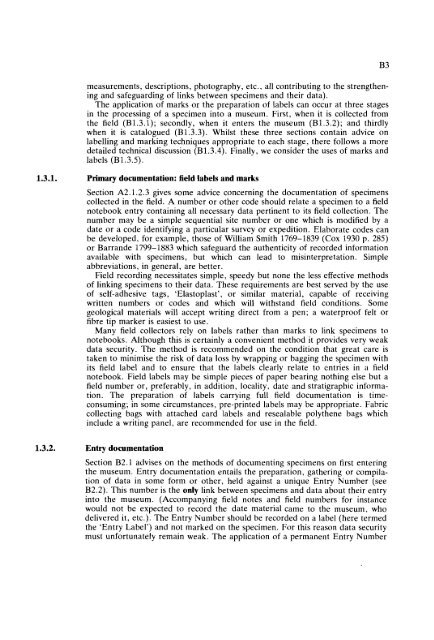GUIDELINES FOR THE CURATION OF GEOLOGICAL MATERIALS
GUIDELINES FOR THE CURATION OF GEOLOGICAL MATERIALS
GUIDELINES FOR THE CURATION OF GEOLOGICAL MATERIALS
Create successful ePaper yourself
Turn your PDF publications into a flip-book with our unique Google optimized e-Paper software.
measurements, descriptions, photography, etc., all contributing to the strengthening<br />
and safeguarding of links between specimens and their data).<br />
The application of marks or the preparation of labels can occur at three stages<br />
in the processing of a specimen into a museum. First, when it is collected from<br />
the field (B1.3.1); secondly, when it enters the museum (B1.3.2); and thirdly<br />
when it is catalogued " IB1.3.3). Whilst these three sections contain advice on<br />
labelling and marking techniques appropriate to each stage, there follows a more<br />
detailed technical discussion (B1.3.4). Finally, we consider the uses of marks and<br />
labels (B1.3.5).<br />
Primary documentation: field labels and marks<br />
Section A2.1.2.3 gives some advice concerning the documentation of specimens<br />
collected in the field. A number or other code should relate a specimen to a field<br />
notebook entry containing all necessary data pertinent to its field collection. The<br />
number may be a simple sequential site number or one which is modified by a<br />
date or a code identifying a particular survey or expedition. Elaborate codes can<br />
be developed, for example, those of William Smith 1769-1839 (Cox 1930 p. 285)<br />
or Barrande 1799-1883 which safeguard the authenticity of recorded information<br />
available with specimens, but which can lead to misinterpretation. Simple<br />
abbreviations, in general, are better.<br />
Field recording necessitates simple, speedy but none the less effective methods<br />
of linking specimens to their data. These requirements are best served by the use<br />
of self-adhesive tags, 'Elastoplast', or similar material, capable of receiving<br />
written numbers or codes and which will withstand field conditions. Some<br />
geological materials will accept writing direct from a pen; a waterproof felt or<br />
fibre tip marker is easiest to use.<br />
Many field collectors rely on labels rather than marks to link specimens to<br />
notebooks. Although this is certainly a convenient method it provides very weak<br />
data security. The method is recommended on the condition that great care is<br />
taken to minimise the risk of data loss by wrapping or bagging the specimen with<br />
its field label and to ensure that the labels clearly relate to entries in a field<br />
notebook. Field labels may be simple pieces of paper bearing nothing else but a<br />
field number or, preferably, in addition, locality, date and stratigraphic information.<br />
The preparation of labels carrying full field documentation is timeconsuming;<br />
in some circumstances, pre-printed labels may be appropriate. Fabric<br />
collecting bags with attached card labels and resealable polythene bags which<br />
include a writing panel, are recommended for use in the field.<br />
Entry documentation<br />
Section B2.1 advises on the methods of documenting specimens on first entering<br />
the museum. Entry documentation entails the preparation, gathering or compilation<br />
of data in some form or other, held against a unique Entry Number (see<br />
B2.2). This number is the only link between specimens and data about their entry<br />
into the museum. (Accompanying field notes and field numbers for instance<br />
would not be expected to record the date material came to the museum, who<br />
delivered it, etc.). The Entry Number should be recorded on a label (here termed<br />
the 'Entry Label') and not marked on the specimen. For this reason data security<br />
must unfortunately remain weak. The application of a permanent Entry Number

















